人類賴以生存的空間被地球內(nèi)稟磁場形成的磁層保護(hù)著����,磁層的外邊界稱為磁層頂���。近些年���,研究人員發(fā)現(xiàn)磁層頂附近區(qū)域在軟X射線波段是明亮的。軟X射線的輻射機(jī)制是太陽風(fēng)電荷交換(Solar Wind Charge Exchange����,簡稱SWCX)過程,即太陽風(fēng)中高價(jià)重離子和地球大氣逃逸的中性成分發(fā)生碰撞�,由激發(fā)態(tài)向基態(tài)躍遷的過程中發(fā)出光子。因此��,太陽風(fēng)能到達(dá)的區(qū)域就會輻射X射線����,而X射線波段明亮和黑暗的交界線就是太陽風(fēng)發(fā)生繞流的邊界,即磁層頂���。
基于此�,中國科學(xué)院和歐空局聯(lián)合提出了太陽風(fēng)-磁層相互作用全景成像衛(wèi)星項(xiàng)目(Solar wind Magnetosphere Ionosphere Link Explorer,簡稱SMILE)�,對日下點(diǎn)附近的磁層頂、部分極尖區(qū)和地球極光進(jìn)行成像探測�,同時(shí)對磁場和等離子體進(jìn)行原位測量,旨在揭示太陽風(fēng)-磁層相互作用的基本模式���,從系統(tǒng)尺度上深入認(rèn)知太陽風(fēng)-磁層-電離層耦合的基本物理過程。SMILE衛(wèi)星計(jì)劃于2024~2025年發(fā)射�。在X射線二維圖像數(shù)據(jù)和磁層物理規(guī)律的認(rèn)知之間起到橋梁作用的是如何由圖像數(shù)據(jù)分析出三維磁層頂位形。這是SMILE項(xiàng)目預(yù)先研究的核心內(nèi)容�����。
近日��,中國科學(xué)院國家空間科學(xué)中心太陽活動與空間天氣重點(diǎn)實(shí)驗(yàn)室王赤院士與孫天然研究員總結(jié)了由磁層X射線二維圖像反演三維磁層頂?shù)乃姆N方法����,給出了磁層成像數(shù)據(jù)分析的“工具箱”。該綜述文章總結(jié)了切向擬合法(Tangent fitting approach, TFA����,圖1)[Sun et al., 2020]、邊界擬合法(Boundary Fitting approach, BFA)[Jorgensen et al., 2019a, 2019b]、切線方向法(Tangent direction approach, TFA)[Collier and Connor, 2018]�、和計(jì)算機(jī)斷層分析法(Computerized tomography approach, CTA)[Jorgensen et al., 2022, Wang et al., 2022]這四種方法的優(yōu)點(diǎn)和局限,指明了各自的適用范圍�,如表1所示。天氣室徐榮欄研究員���、孫天然研究員與美國新墨西哥理工大學(xué)的Anders Jorgensen等人合作���,給出了磁層頂反演的CT方法。針對CT方法�,天氣室孫天然與系統(tǒng)室李大林副研究員、博士生王榮聰?shù)热碎_展合作�����,采用人工智能技術(shù)對軌道未能覆蓋的觀測角度進(jìn)行圖像補(bǔ)全�����,反演得到三維磁層頂位形�,如圖2。孫天然及合作者對磁層X射線研究進(jìn)展進(jìn)行了綜述���。
表1 磁層成像數(shù)據(jù)分析的“工具箱”[摘自Wang and Sun, 2022]
圖1 采用切向擬合法TFA�����,由磁層X射線圖像(左)反演三維磁層頂(右)[摘自Sun et al., 2020]
圖2 人工智能應(yīng)用于CT反演方法����。左、中圖為X射線輻射率在子午面和赤道面的等值線��,右圖為三維磁層X輻射率反演結(jié)果 [摘自Wang et al., 2022]
該系列成果發(fā)表在空間物理權(quán)威期刊Geoscience Letters�、Journal of Geophysical Research等雜志上。研究得到了基金委重點(diǎn)項(xiàng)目��、中國科學(xué)院前沿科學(xué)重點(diǎn)研究計(jì)劃����、空間科學(xué)戰(zhàn)略先導(dǎo)計(jì)劃����、中國科學(xué)院研究基金和國家重點(diǎn)實(shí)驗(yàn)室專項(xiàng)研究基金、青促會優(yōu)秀會員資助計(jì)劃等的支持����。
References:
1.Wang, Chi*, and Sun, Tianran*; Methods to derive the magnetopause from soft X?ray images by the SMILE mission, Geoscience Letters, 9:30, 2022, https://doi.org/10.1186/s40562-022-00240-z
2.孫天然*����,張穎潔��,韋 飛�����,彭松武����,堯中華����,王赤*,地球磁層軟X射線信號的輻射特性研究���,地球與行星物理論評��,2022�,accepted
3.Wang, Rongcong, Li Dalin*, Sun Tianran*, Peng Xiaodong, Yang Zhen, Wang J.Q., A 3D Magnetospheric CT Reconstruction Method Based On 3D GAN and Supplementary Limited-Angle 2D Soft X-ray Images. Journal of Geophysical Research: Space Physics, 2022, accepted
4.Jorgensen, A. M.*, Xu, R., Sun, T., Huang, Y., Li, L., Dai, L., & Wang, C. A theoretical study of the tomographic reconstruction of magnetosheath X-ray emissions. Journal of Geophysical Research: Space Physics, 2022, 127, e2021JA029948. https://doi.org/10.1029/2021JA029948
5.Sun T.*, Wang C.*, Connor H. K., Jorgensen A. M., Sembay S; Deriving the magnetopause position from the soft X-ray image by using the tangent fitting approach; Journal of Geophysical Research: Space Physics; 2020, 125, e2020JA028169. https://doi.org/10.1029/2020JA028169
6.Sun T. R.*, Wang C.*, Sembay S. F., Lopez R. E., Escoubet C. P., Branduardi-Raymont G., et al.; Soft X-ray imaging of the magnetosheath and cusps under different solar wind conditions: MHD simulations; Journal of Geophysical Research: Space Physics; 2019, 124. https://doi.org/10.1029/2018JA026093
7.Jorgensen A. M., Sun T.*, Wang C., Dai L., Sembay S., Wei F., et al.; Boundary detection in three dimensions with application to the smile mission: The effect of photon noise; Journal of Geophysical Research: Space Physics; 2019a, 124. https://doi.org/10.1029/2018JA025919
8.Jorgensen A. M.*, Sun T.*, Wang C., Dai L., Sembay S., Zheng J. H., Yu X. Z.; Boundary Detection in Three Dimensions With Application to the SMILE Mission: The Effect of Model-Fitting Noise; Journal of Geophysical Research: Space Physics; 2019b, 124. https://doi.org/10.1029/2018JA026124
?����。ü└澹禾鞖馐遥?/div>




